 |
||
|
|
|
Celebrating the pipe organ, the King of Instruments |
About the Authors Brad Althoff is associate producer for Pipedreams and an accomplished organist living in the community of Saint Paul, Minnesota. Michael Barone is the host of American Public Media’s long-running program Pipedreams. |
Notes from the Road
April 28 - May 11, 2006
Day 12 - Kuhn Organ Shop, Muri, Saint Peter’s
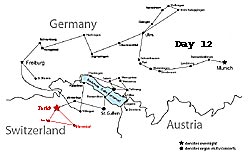 |
Kuhn’s organ shop was great. So many tools…so many possibilities. Watching the workers pour a sheet of metal was fascinating. To see how an instrument is put together just gets my mind going.
Muri Abbey should be on every early music person’s must-go-see-before-I-die list. There are not one, not two, but THREE instruments from the 1700s. The current organist and his retired predecessor played a duet from across the gallery for us. They were great. It was a very impressive display. The flip side being that you could only play in the keys of C, G & F. It was a simpler time. We took a group photo here on the steps leading up the Abbey.
 |
Things to remember: wondering if I would have altitude problems (I didn’t), LOTS of early music, goats with little bells (they were terribly cute), running around getting pictures of everyone, trying to find a souvenir shop, learning that the exchange rate was FINALLY in favor of the dollar, and traffic in Zurich is unbelievably bad.
Posted by Brad Althoff
——————————
On our last day, occasional bursts of sunshine added to the dynamic of our drive along Lake Zurich to the Kuhn organ-building shop. Dieter Utz, chief executive, greeted us as Dieter Rufenacht, director of new projects, heralded us with a lively performance of a typical Swiss mountain tune played on a little instrument in the manner of the house organs beloved of wealthy Swiss farmers. Our group received a brief but informative introduction in the matters of pipe metal casting, pipe making and voicing, slider chest design and mechanical action function. Some would have happily spent more time, as apprentices-for-a-day.
 |
 |
By this point, some of the group were ‘organed out’, so the remainder of the afternoon was given over to strolling, shopping, and preparing for our final dinner together. Next morning, we’d arise, head to the airport, hoping to remember some of what we’d all enjoyed together during the past nearly two weeks. So many organs, so little time…and already people were asking: “Where are we going next year?!”
Posted by jmb
Day 11 - Saint Gallen, Winterthur, Zurich Grossmünster
Gray day. Cold. Rainy. Wet feet. Yep, I’m lovin’ Switzerland.
 |
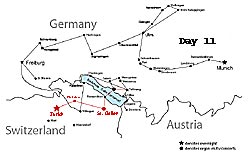 |
Things to remember: Saint Gallen, all of it; that reformed/protestant churches in Europe are downright boring to look at; next trip, bring an umbrella; when you order a vodka martini, up, with an olive be aware that, in Zurich, you’re going to get a glass of Vermouth; being homesick.
Posted by Brad Althoff
——————————
Despite a gloomy, rainy day, our visit to the Cathedral of Saint Gallen, another immense and imposing space with its adjoining World Heritage Site library, provided numerous revelations. Willibald Guggenmos amiably demonstrated the luminous quality of the huge Kuhn organ, which made me wonder why that firm’s work had been ‘overlooked’ when the city of Lucerne chose Fisk to build the new organ in their cathedral. We were also treated to a display of the twin 18th century Choir organs, rebuilt by Mathis, playable separately or, from one conle, together, all by mechanical action. The ancient manuscripts and books, and the well-preserved mummy, in the library (and the intricate woodwork of the library rooms themselves) reminded one of the sterile information-sharing via the internet of our modern computer age. The search is half the experience.
 |
Our day ended in Zurich, Switzerland’s largest city, very urbane but also picturesque as it straddles the Limmat River. Since the ancient Grossmünster served as a starting point for Zwingli’s Reformation, it’s appropriate that the 1960 Metzler tracker organ remains as testament to the vitality of the postwar Baroque Revival movement. Despite impressive external proportions, the interior of this church is not a huge resonant cavity, with relatively sedate acoustics. Best listening is from the elevated chancel, which is almost level with the organ gallery (the nave is sunken a good 20 feet below both). Lionell Rogg’s Bach recordings on this instrument were considered among the very best of their day, and still offer revelations.
Posted by jmb
Day 10 - Lindau, Bregenz, Dornbirn, Haselstauden
 |
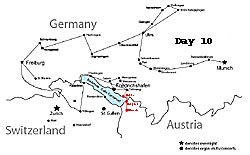 |
Things to remember: Flowers in Lindau, having coffee and comparing stories with our driver about talking our way out of traffic tickets, the improvisation at Bregenz (My Old Kentucky Home), flute en chamade, a concert event with Ivana.
Posted by Brad Althoff
——————————
Lindau is a picturesque port town on an ‘island’ in Lake Constance…actually easily accessible via a very short causeway from the mainland. Perhaps the most intriguing aspect of this reconstructed 1928 Steinmeyer organ was the ‘echo’ division that plays at the opposite end of the church. A substantial 2-manual Maier transcept tracker organ (in the manner of the Saxon Silbermann) provides for tonal variety.
 |
The day culminated with a ‘command performance’ by the impressively talented Latvian soloist, Iveta Apkalna, who demonstrated the Opus 1 of Caspar Glatter-Götz in the Dornbirn suburb of Haselstauden. In 2005, Ms. Apkalna was named “Musician of the Year” accolade by the German-based ECHO-Klassik, which brought with it a flurry of publicity and opened up an opportunity at international stardom. The skills she demonstrated for us would seem to point to a successful future. She shared our supper at the gasthaus across the street, and then departed to continue her drive to Rotterdam, site of her next concert engagement. Our group was invited into the organ balcony to watch her perform George Thalben-Ball’s variations (for organ pedals!) on a Theme of Paganini.
Posted by jmb
Day 9 - Weingarten, Weissenau & Salem
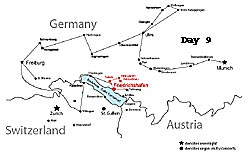 |
Today was my new favorite day. I slept well (FINALLY) and was about as bright-eyed and perky as I ever get before 10 a.m. The first stop of the day was Weingarten - yep it’s a cognate - and it was everything I could have hoped for. Like numerous other places, it is trés immense, but the organ was simply a marvel of engineering and sound. It is a very gentle organ
 |
Weissenau was pleasant enough, but Salem was the hidden treasure of the day/tour. Up to this point, all of the churches we had stepped foot in had walls that were either guilded or painted, but in Salem (and when our guide said it, it sounded suspiciously like Sodom - my friends at home will have a field day with that one) all of the décor was stone and marble. $$$$$$. The organ was gorgeous and it was played for us by the great, great grandson of Karg-Elert. Considering the nature instrument and how awkward the action would’ve been for me, a spoiled American, he played brilliantly!
Things to remember: All of Weingarten; searching for a cup of coffee on a Sunday morning (good luck!); thinking I could make it between toiletten stops; balcony stairs that would NEVER pass code in the U.S.; Karg-Elert’s great, great grandson playing for us at Salem; the priest/host at Salem; palm trees on an organ with cherubs that from 50 meters looked like primates; Sequoias at the Abbey; watching/hearing Nigel Kennedy perform and then learning that he’llsoon be 50.
Posted by Brad Althoff
——————————
Weingarten Basilica is one of those wonderous places, among of the largest Benedictine cloisters in Swabia and the largest Baroque church north of the Alps. After climbing up a considerable number of steps to reach the plaza in front of the church from the street below, one enters and confronts the incredible Gabler organ in its west-end balcony. This organ, quite incredibly, surrounds three large windows, the ornate casework decorated with carved vines (and round bells, masquerating as large grapes!), and a
 |
Because of its complex construction and large specification, some of the Weingarten organ’s pipework is a bit buried, and the instrument’s sound is not at all bombastic in this immense room, a point which had been criticized since the organ’s inauguration. I would not complain. The organ does not lack a pungent punch, nor an ability to ably lead congregational singing (though the service we heard, a First Communion, was not in any way noteable for the quality of its music…the Gabler was organ used only at the prelude and postlude…everything else, except the final hymn, was accompanied by an amplified piano). The youthful organist Stephan Debeur, seemed more than a bit
 |
Wandering in the vicinity of the church, we discovered some lovely garden parks, a 1961 Panhard PL17 (a French econocar from the late 1950s in exceptional condition, parked in a residential driveway), plus a very new, huge Rolls-Royce parked in the church lot (to whom did it belong?).
Moving on, the Holzhey organ at Weissenau (41 stops), if not quite so large or unusual as the Weingarten Gabler (66 stops), was equally satisfying to play and perhaps benefitted from its relatively concise format. Ulrich Hoeflacher’s demonstration recital propelled a glorious tone throughout every corner of this not insubstantial room. Here, (unlike at Obermarchtal) the Kronwerk actually contained functioning pipes.
We munched on our box lunches while driving to Salem (the former abbey now functioning as a highly regarded boarding school and small ‘artisans colony’), where we were treated to a brief guided tour of the
 |
Then a mad dash to Friedrichshafen for a change of pace, a performance by the Polish Chamber Orchestra and violinist Nigel Kennedy (part of the Bodensee Festival). Kennedy was his usually quirky self, in hobnail boots, informal garb, spiked hair and ‘street slang’ speech mannerisms. At the Graf-Zepplin Haus (sorry that we didn’t have time to visit that museum), he played the Elgar Concerto as well as anyone should, plus a superb and little-know late-romantic concerto by Emil Mylnarski. Nigel tossed his bouquet into the crowd (also kicked a soccer ball to them), and played lengthy encores (a Bach concerto, an improvized czardas), which brought the total concert time to nearly three hours…causing a late night return to Tettnang, but the experience was well worth it. Manuela reported that she had driven a bus for one of Nigel’s previous tours with the Polish Chamber Orchestra, but was mum about details (other than that she stayed in a hotel separate from Kennedy and the musicians…).
Posted by jmb
Day 8 - Villingen, Radolfzell, Überlingen
Today we visited communities with great edifices, organs, and markets, but what I remember is a fountain. The weather in Germany up to this point, excluding the first day, has been stunningly beautiful. 70-75 degrees and sunny. Our locale today was around Lake Constance. And it was the same. Beautiful.
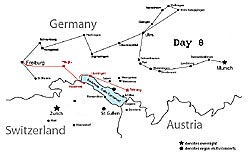 |
 |
Posted by Brad Althoff
——————————
Villingen, due east of Freiburg, is another medieval town with roots stretching back over centuries. The town hosts a spring festival which celebrates the ‘old days’, and all sorts of artisans, craft folk, and musicians in period costume were encamped just outside the ring of the town’s old fortification walls. Would that we had had more time to mindle amidst the morning sunshine. But our schedule was tight as we scampered towards Saint George’s church, which offered another connection to history. Johann Andreas Silbermann had built a fine 3-manual organ for this church in 1752, but it was removed in 1807, ‘donated’ to another church as a result of the politics of the early 19th century ‘secularization’ of monastery facilities. After much soul searching and fund-raising, the present congregation in 2002 contracted with Gaston Kern for a replica of the Silbermann, which is a delight to see, hear, and play. Ulrich Kohlberg provided ample demonstration, after which those in the group with itchy fingers could give it a try. Time allowed also for a brief demonstration of the new Minster organ a few blocks away, with its ornate, gilded case. Hans Hielscher included Happy Birthday (for Lise S.) in his improvisation.
 |
Afterwards, the cathedral in Überlingen was more impressive than its 1968 organ, though the little renovated 1761 single-manual choir instrument was not without charm.
Perhaps the best part of this day was our stop along the shore of Lake Constance (on the way to our hotel in Tettnang) for our final ‘birthday surprise’ (with wine, snacks and flowers) for Lise S. She seemed to enjoy it (was grinning from ear to ear!)…
Our residence for the next several nights was the cozy Hotel “Rad” in Tettnang, a modest town some 10km north of Friedrichshafen. Though they ripped up the street outside the hotel the day after our arrival, this simply provided our superb driver, Manuela, with a few extra challenges to showcase her expert coach-maneuvering skills.
Posted by jmb
Day 7 - Schramberg, Freiburg, & Saint Blasien
The cold is making itself known today. I didn’t sleep well last night because of the meds I took before I went to bed (BAD nightmares) so this morning was particularly slow-going. In a very cruel turn of events, I sat next to someone on the way to Schramberg (locale of church #1 of the day) who wanted to talk…A LOT. I should’ve said something about needing some quiet time, but didn’t.
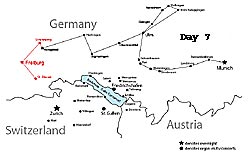 |
Freiburg, like Ulm, is Gothic in all the dark, gloomy ways that an old European Cathedral is supposed to be. It is not the church in the Sound of Music where Maria gets married. Boy-howdy, no. Maybe the Adams Family, but not Maria.
Interestingly, Freiburg has 5 organs positioned around the nave and like Ulm… I was hoping for something more. Like volume. The place is trés immense, but the sound is relatively weak. Not a good combination. Looking back, my stuffed up head could have altered my perception a bit - I don’t think a battery of chamades could have gotten through my fog, but I do remember that Hans played it beautifully.
 |
Things to remember: Gigout (again) in Saint Blasien; ATMs need to display the VISA symbol (dooh!); the necessity at times for peace and quiet, as well as dealing with the socially oblivious; the smoooooooth organ in Schramberg; FREE internet in Saint George’s (that night’s hotel).
Posted by Brad Althoff
——————————
From our woodland mountain hideaway we continued on twisting roads through the Black Forest to the little city of Schramberg, famous for its wood products and clocks. The town is wedged into a narrow, downward-sloping valley, through which runs a substantial mountain stream. Saint Mary’s Church, with its separate bell tower adjacent said stream, is a product of the town’s 19th century prosperity. Though the interior decorations and fittings are now decidedly modern
 |
Up to this point, we’d visited churchs with one or perhaps two organs. At Freiburg Minster, an important city just outside the Black Forest, we found four organs in one room (!), all relatively recent, all connected together via a compact electric-action console. Back in the 1970s, E. Power Biggs made these organs famous with his recording of Bach Toccatas in ‘quadraphonic sound’. From that, I expected a larger space, and was surprised by the relative intimacy of the place, and by the grand overall experience (enhanced by the recent Caspar Glatter-Götz revoicing of the ensemble’s large Rieger organ). Amazingly, were were allowed an hour’s free reign at the main console following the midday service.
Because of scheduling necessities, though we would spend overnight in Freiburg we retraced some of our tracks back into the Black Forest, destination Saint Blasien, a Benedictine stronghold with an immense late 18th century domed church in the manner of the Pantheon. The 1913 Schwarz organ, behind a facade adapted from the original J. A. Silbermann, projects
 |
Freiburg was sunny and warm during our noontime visit (the area around the church was, as has been the case since medieval times, ringed with farmer and merchant stalls), but rain showers caught up with us during our travels to and from Saint Blasien. By good fortune, virtually all of the rain fell while we were either in the bus or in the church, so a trot across the street (and stream…another mountain river flowed through Saint Gallen) to a conveniently located bakery for a snack of authentic Black Forest Cake was accomplished sans umbrella.
Posted by jmb
Day 6 - Obermarchtal, Sigmaringen, & Hechingen
I have entered a Tolkein novel. This morning, after another rather hearty breakfast - truth be told, there is absolutely NO light fare in Germany - we packed up and left Ulm. Over the course of the day we saw a very modern organ, a positively ancient one that further reinforced everything I have ever been taught about mean-toned temperaments, two castles (we had a birthday party in the shadow of one) and later that evening arrived at our lodge at the edge of the Black Forest. My room is in a separate building from the main lodge so I hope that I don’t run into a bear on the quick walk outside back to my room.
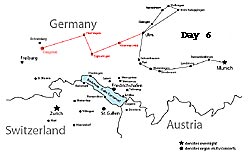 |
Things to remember: the refectory at Obermarchtal; ALWAYS go to the bathroom when given the opportunity; castles rock!; the relationship between princes and the Church; running into people from Stillwater, Minnesota in the lobby of the lodge; and God help me - the size of an organ does not matter. I have always thought otherwise, but I now realize I was wrong. Maybe.
Posted by Brad Althoff
——————————
All that glitters is not necessarily as it at first seems. For instance, though an interesting little pipe facade balances gracefully above the gallery window at Obermarchtal Abbey, the Holzhey organ’s Echo-Kronwerk chest and pipes actually reside in the upper part of the right-side main case, with no pretense of playing
 |
Obermarchtal today is used primarily as a middle-school for girls (and for other church-related educational programs), and on the morning of our visit the place was crawling with giggling teenagers who seemed somewhat out of place amidst the rococo elegance of these majestic old buildings (note the picture of the refectory!). Still, it is best that such facilities be used.
In the shadow of a Hohenzollern family castle, Saint John’s Church in the elegant little city of Sigmaringen (nestled on a strategic promontory and oozing plenty of historic charm) boasts two ‘new’ organs. The gallery instrument, from 1995, satisfactorily embraces the Alsacian style of Andreas Silbermann (though one rarely mistakes new-old-style organs for authentic historic instruments, either by touch or tone). On the other hand, virtually everything (except the pipes!) of the little choir organ down
 |
[Our tour guide Ulrich, who is employed in Berlin as an ‘art archivist’ for the Hohenzollern family, provided us with many historic details concerning the rule of this important Swabian dynasty. To read more about the Hohenzollerns, who ruled in Swabia from the eleventh through the nineteenth centuries, click here. Note that the Saint Luzen chapel rests in the valley below, obscured by the tallest tower of the Hechingen castle pictured at this website.]
Hechingen is another Hohenzollern city (same family, different branch). The affable Mario Peters, organist at Saint Jacob’s Church (the only significant church in town), enjoyed showing us the modern, eclectic double-organ Goeckel at the Stiftskirche (a mechanical-action gallery and an electric-action choir organ, both with very interesting modern facades and playable together from a large electric-action console with all the modern aids located downstairs). An interesting feature is the “Jacobus” stop which, when pulled, causes the organ to automatically play the folk-song Frere Jacques (on any registration you select), while a little carved head of Brother Jacob pops out from hiding behind the upper left-hand-corner facade pipes (sorry, no picture).
Mario Peters has been resident organist in Hechingen for about nine years, got the job just by chance (few others were interested, as the city is somewhat isolated), and the place because it has the advantages of a modest modern urban center yet is still sufficiently small-townish to be great for raising children (he has three daughters). Plus he has the big organ at Saint Jacobus…sufficient for playing all of the ‘grand’ repertoire, from Mendelssohn to Messiaen…AND access to the Hohenzollern family chapel across the river at Saint Luzen.
This picturesque chapel (from which one can see the Hohenzollern’s Hechingen castle, perched fairy-tale-like on its mountain across the valley) is home to an organ with 17th century double-fronted case. The instrument, reconstructed in historic fashion, again
 |
This day, again sunny from beginning to end, encouraged more midday dining outdoors (most restaurants had numerous tables, and umbrellas, arrayed along the cobbled, narrow walking-streets). Following our visit to the Saint Luzen chapel, before heading into the Black Forest for our overnight in Koenigsfeld, we drove up the mountain road towards the Hechingen castle and stopped on a grassy plateau just below the fortress to break out cake, cookies and wine in celebration of Dave A.’s natal day. Though this guy gets around, I expect that he’s never been feted in quite this way (or in quite this setting) before!
Our overnight destination was a woodsy retreat, modern accomodations in the structure of a turn-of-the-century country lodge. A plentiful and tasty dinner buffet, including many ‘regional favorites’, sated every hunger. Gad, even with all the walking, there is no chance that I will lose weight during this trip!
Posted by jmb
Day 5 - Mönchsdeggingen, Maihingen & Neresheim
 |
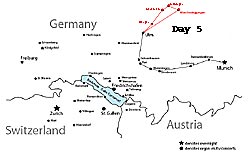 |
In the imposing Neresheim Abbey (almost a fortress on a hillside above the town), the colorful pictoral frescos of the ceiling contrast with the neo-classical white of the remainder of the interior. The Holzhey organ ingeniously surrounds four windows in the gallery, and makes an impressive, noble sound in the 8-second resonance of this large room. We lunched in the public refectory, then traveled to the Steiff Toy Factory and Museum in Giengen, home of the Teddy Bear. Couldn’t ask for a finer day’s diversion.
Posted by Michael Barone
 |
On a completely unrelated subject, I’ve also discovered that sauerkraut is it’s own food group and that what we have in Minnesota is NOT sauerkraut. YUM!
This picture is of the front altar at Neresheim Abbey, where I discovered that I love shredded cabbage and radishes. I’ve reached a nexus, now there’s no turning back…
Posted by Brad Althoff
Day 4 - Rot-an-der-Rot, Ochsenhausen & Ulm
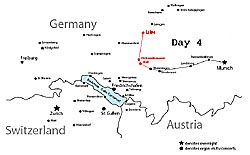 |
 |
On to Ulm, an immense, intricate Gothic structure with the tallest tower in Germany (or is it second-tallest…I did not climb the zillion stairs to get what Jon Gosset reported was a spectacular view). We were on our own here for two hours, and after Hans Hielscher played a full Rheinberger Sonata to demonstrate the 1969 Walcker, everyone who would/could tried their hands, too. Despite its immensity, the organ’s mechanical action is not at all a problem, and though its tonal scheme may not be a la mode, it is a good instrument (not too loud, but strong enough). Another fine day.
Posted by Michael Barone
 |
On the personal side, I went for a long walk last night (45 minutes) around Ulm. In Minnesota, I exercise regularly. I haven’t been able to run or go to the gym on this trip, to this point, and it has caused my blood sugar to go a little nuts, but last night’s walk certainly helped.
Things to remember: BEAUTIFUL Ochsenhausen; immaculate pastures; Maltauschen - heart attack comfort food; frightening religious statues & relics; Ulm’s old city.
Posted by Brad Althoff
Day 3 - Fürstenfeldbruck, Landsberg, Ottobeuren & Memmingen
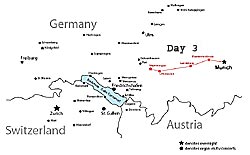 |
Landsberg Stadtkirche is not quite so overtly decorated as Fürstenfeldbruck, and the organ (2001 Schmid in an 18th century case) of contemporary all-purpose design. Siegfried Schmid himself was present to show us his handiwork. The town itself was captivating, too, with its sun-drenched cobble-stone plaza surrounded by age-old buildings (from the 16th century or earlier)…this isn’t Kansas (or Minnesota, or anywhere in the States) any more, Toto!
Ottobeuren Abbey is one of the ‘great organ destinations’, and the twin choir organs showcase the ingenuity of their 18th century builder (and successful wine merchant) Josef Riepp. The Maibaum (May Pole) in the side yard reminded us that this was May Day…a holiday throughout Europe (their Labor Day). Thanks to Josef Miltschitzky for sharing the instrument with us, of which he is justifiably proud. Suffice it to say that already another ‘high point’ was reached on the trip, and we’ve only just begun.
 |
Posted by Michael Barone
Yesterday was a great day in Germany! The weather was cool, but sunny. In fact, the most memorable parts of the day had more to do with living and peripheral issues than with organs/churches. The most significant realization is that I’m going to move to Landsberg when I retire, if not before. I did not know what to expect when I read up on Landsberg. I knew it was a small town with a significant instrument. That was it. When we arrived, though, it was a perfect little German town. There was a castle, a city wall and buildings that looked like they were conceived by Disney. I sat with our driver, Manuella, at a cafe on the platz and drank “gassed” water for an hour and a half. Just sitting, feeling the cool sun (I’ve yet to take off my leather jacket and gloves), and thinking that of all the possible ways to live, this was far from the worse.
Also, I swear that the hotel we stayed at last night was haunted. I woke up many times to what sounded like a party going on in the hall outside my door, but when I looked out there was no one there. Not anyone. Call me nuts, but with buildings/businesses several hundred years old, I think it’s entirely possible that some people have decided to linger.
I’ve taken lots of pictures and hope to post them soon. Connectivity has been a problem.
Posted by Brad Althoff
Day 2 - Munich
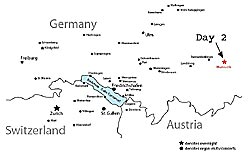 |
Remember that this huge church was mostly demolished (excepting the tall twin towers…see picture) during Allied bombing. Its reconstruction has been a lenghthy and costly proposition, but a proud city again has a proud monument. Hans Leitner is the new Frauenkirche music director (formerly at Passau Cathedral, where I last saw him in 2001).
 |
Stefan Moser introduced us to the instruments at the Saint Franziskus (Catholic) and Saint Lukas (Lutheran) churches, though he is not organist at either of these. He claimed to have been only once before at Saint Franziskus, and not familiar with the organ, yet sat down and played us ‘a little piece’ …the Toccata from Duruflé’s Suite Opus 5, flawlessly and from memory. This van den Heuvel organ, a recent Dutch construct in the manner of 19th century French symphonic organs, may have been a bit intense in its gallery, but sounded quite good downstairs (which, after all, is there the people hear it). Despite a space-age modern console at Saint Luke’s, the neo-classical instrument did not impress, though Stefan’s performance of Robert Elmore’s “Rhumba” did (fancy footwork).
Following a ‘typical Bavarian dinner’ at the Haxnbauer Restaurant, we all went to the Munich Philharmonic (a contemporary hall) for an all-Mendelssohn orchestra program accompanied by attractive still-photos of scenes from Scotland (the music was the Scots Symphony and Hebrides Overture)…though I cannot say that this proved to be much of a revelation (either the content or the technology involved), though the audience seemed to lap it up.
Posted by Michael Barone
Last night I had the most divine sleep I’ve had in a couple of months. Love the hotel! The Mercure in Munich is well worth your time if you’re in the city. Breakfast rocked! GOOD coffee (which is easily 50% of my attitude towards breakfast), and all varieties of eggs, meats, cheeses, breads, cereals, yogurts, fruits and juices - it made the continental breakfasts back in the States look pretty cheap.
First church of the day was the Frauenkirche. It is my favorite church/organ of the tour so far has been and this utterly gigantic church houses a beautiful organ in the rear gallery. There were a number of us that got to play it and, frankly, the organ made me sound better than I had any right to sound. I played Grand Choeur Dialogue by E. Gigout and abused the downright garish reverb of the room. Lots of fun but the organ and the room did all the work.
 |
I was advised before the trip began to bring my hat & gloves, as well as my coat. I have yet to take off any of them off inside the churches. Brrrrrrrrrrrrrrrrrr!!!!
- Posted by Brad Althoff
Day 1 - Munich
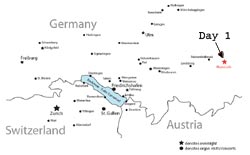 |
 |
A note: approximately 40% of the folks on this tour have been on past PIPEDREAMS expeditions. Some have been on all of them (five), so the dynamic was a bit like a reunion of distant cousins and, in the case of the ‘new arrivals’, welcoming them into the family. They are an amazingly diverse and amiable group, and I love them all.
- Posted by Michael Barone
It was a little strange for me to come down from behind the clouds on Saturday morning and see the green fields that stretched out to the horizon. My father’s grandparents were from Germany, and little did I know that within the course of a few days, I would see the faces of my extended family again and again.
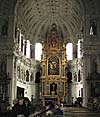 |
The original Saint Peter’s Church was largely destroyed in World War II. It may have been completely razed, but the priest in charge at the time pushed through an initiative to restore the church. The organ, built in 2003, seemed to be loud and aggressive from the bench, but in the cavernous room it sounded great! It had a number of modern features, and an unusual pedal board that I couldn’t make peace with. When I tried to play the organ, my feet were almost always in the wrong place. In hindsight, I may have just needed a nap.
Saint Michael’s is a stunning example of Renaissance architecture. Like Saint Peter’s it has a relatively new instrument. The organist in residence played a few pieces that really showed off what the organ could do. Very impressive. Like the other, this church had amazing acoustics for an organ.
Things to remember - Marianplatz glockenspiel, the Ratskeller, the faces in Saint Peter’s after Mass, playing “the Primitive’s” in 8 seconds of acoustic, the architecture of Saint Michael’s and how utterly good a hot shower felt at the end of the day.
- Posted by Brad Althoff


